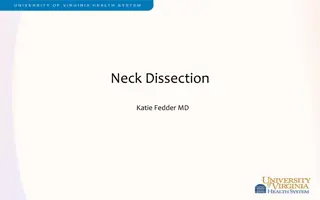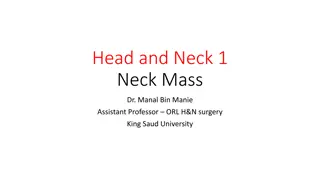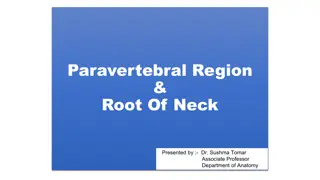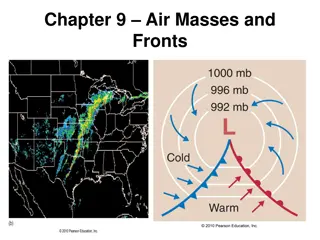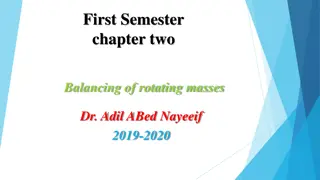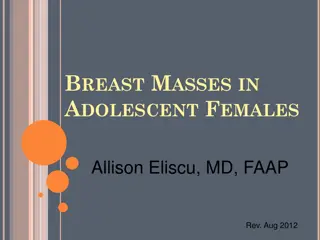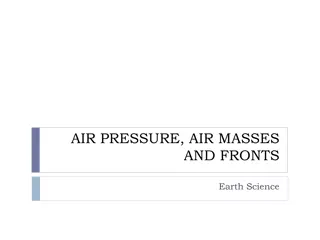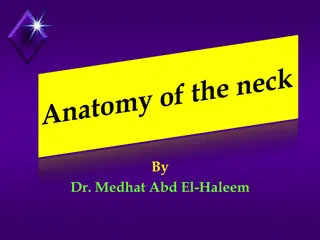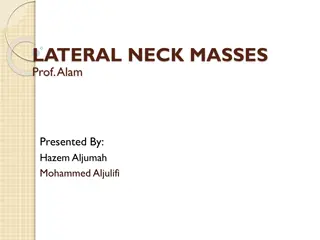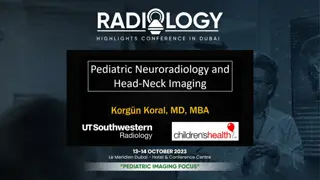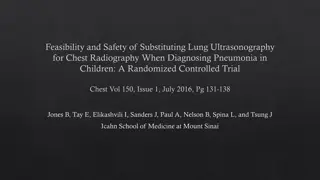Pediatric Neck Masses: Causes and Anatomy Explained by Dr. Nitin Sharma
Learn about pediatric neck masses, their causes including congenital, inflammatory, and malignant factors, and the embryology and anatomy behind them. Detailed insights are provided on the branchial system, its arches, pouches, and the structures they contribute to in the neck. Dr. Nitin Sharma, a highly qualified pediatric surgeon, shares informative details to enhance understanding of these conditions.
Download Presentation

Please find below an Image/Link to download the presentation.
The content on the website is provided AS IS for your information and personal use only. It may not be sold, licensed, or shared on other websites without obtaining consent from the author. Download presentation by click this link. If you encounter any issues during the download, it is possible that the publisher has removed the file from their server.
E N D
Presentation Transcript
PEDIATRIC NECK MASSES Dr Nitin Sharma M B B S(Gold medallist), M S(Gen Surgery), M. Ch. (Paediatric Surgery)(Gold Medallist), AIIMS, New Delhi FISPU, FMAS CRYPTORCHIDISM
CAUSES Congenital Midline Inflammatory Lateral Malignant Random
Embryology and Anatomy Branchial System- 6 pairs of pharyngeal arches separated by endodermally lined pouches and ectodermally lined clefts. Each arch consists of a nerve, artery, and cartilaginous structures. The remaining neck musculature gains contributions from cervical somites.
Branchial system First Branchial arch Maxillary and mandibular (Meckel s) process regress to leave the malleus and incus. Ossification around Meckel s cartilage gives rise to the mandible, sphenomandibular ligament, and anterior malleolar ligaments. Muscles- temporalis, masseter, pterygoids, mylohyoid, ant belly of digastric, tensor tympani, tensor veli palatini
Branchial system First Branchial Arch Pouch Eust tube, mid ear Temporal bone Cleft EAC/TM
Branchial system Second Branchial Arch Reichert s cartilage contributes to the superstructure of the stapes, the upper body and lesser cornu of the hyoid, the styloid process and stylohyoid ligament. Muscles- platysma, muscles of facial expression, posterior belly of digastric, stylohyoid, and stapedius Nerve- 7th cranial nerve Artery- stapedial artery
Branchial system Third Branchial Arch Lower body of the hyoid and greater cornu. Muscles- stylopharyngeus, superior and middle pharyngeal constrictors. Nerve- 9th cranial nerve Artery- common carotid and proximal portions of the internal and external carotid.
Branchial system Third Branchial Pouch Inferior parathyroids Thymus gland and thymic duct
Branchial system Fourth and Sixth Branchial arches fuse to form the laryngeal cartilages. Fourth Arch Muscles- cricothyroid, inferior pharyngeal constrictors Nerve- Superior Laryngeal Nerve Artery- Right Subclavian, Aortic arch Fourth Pouch- superior parathyoid glands and parafollicular thyroid cells
Branchial system Sixth Branchial Arch Muscles- remaining/intrinsic laryngeal musculature Nerve- Recurrent Laryngeal Nerve Artery- Pulmonary Artery and ductus arteriosus
Branchial system Epipericardial ridge- mesodermal elements of the sternocleidomastoid, trapezius, and lingual and infrahyoid musculature. Nerve- hypoglossal and spinal accessory nerve Cervical Sinus of His
Thyroid Gland Endoderm of the floor of mouth between the 1st and 2nd archs. Descends as a bilobed diverticulum from the foramen cecum around the 4th week to rest by the 7-8th week.
Neck Masses Midline Neck Masses Thyroid nodules Cervical Lymphadenopathy Thyroglossal Duct cyst Thymus gland anomalies Plunging ranula Lateral Neck Masses Branchial cleft anomalies Laryngoceles Dermoid and Teratoid Cysts Lymphangioma and Hemangioma
Midline Neck Masses Thyroid nodules Thyroglossal duct cyst Cervical Thymic Cyst Plunging ranula
Thyroglossal Duct Cyst Most common congenital midline mass Asymptomatic mass at or below the hyoid bone that elevates with tongue protrusion. Ectopic thyroid tissue vs. thyroglossal duct cyst?
Thyroglossal Duct Cyst 1-2% have Ectopic Thyroid glands so imaging is indicated to document presence of a normal or ectopic thyroid gland Simple Excision leads to high recurrence rate Sistrunk Procedure Patients at high risk for recurrence- Modified Sistrunk Procedure
Cervical Thymic Cysts Failure of involution of the cervical thymopharyngeal ducts. Firm, mobile masses found in the lower aspects of the neck. CXR, CT scan Surgical Excision- Inferior limit of dissection is the brachiocephalic v.
Plunging Ranula Simple ranula- unilateral oral cavity cystic lesion. Plunging ranula- pierce the mylohyoid to present as a paramedian or lateral neck mass. Cyst aspirate- high protein, amylase levels CT scan/MRI Treatment is intraoral excision to include the sublingual gland of origin.
Lateral Neck Masses Branchial cleft anomalies Laryngoceles Dermoid and Teratoid Cysts Sternocleidomastoid Pseudotumor of Infancy Lymphangiomas and hemangiomas
First Branchial Cleft Cysts Type I Ectodermal Duplication anomaly of the EAC with squamous epithelium only. Parallel to the EAC Pretragal, post auricular Connection with TM or Malleus>Incus Surgical Excision
First Branchial Cleft Cysts Type II Squamous epithelium and other ectodermal components Anterior neck, superior to hyoid bone. Courses over the mandible and through the parotid in variable position to the Facial Nerve. Terminates near the EAC bony- cartilaginous junction. Surgical excision- superficial parotidectomy
Second Branchial Cleft Cysts Most Common (90%) branchial anomaly Painless, fluctuant mass in anterior triangle Inferior-middle 2/3 junction of SCM, deep to platysma, lateral to IX, X, XII, between the internal and external carotid and terminate in the tonsillar fossa Surgical treatment: Excision
Third Branchial Cleft Cysts Rare (<2%) Similar external presentation to 2nd BCC Internal opening is at the pyriform sinus, then courses cephalad to the superior laryngeal nerve through the thyrohyoid membrane, medial to IX, lateral to X, XII, posterior to internal carotid Surgical approach must visualize recurrent layngeal nerves- Thyoidectomy incision
Fourth Branchial Cleft Cysts Courses from pyriform sinus apex caudal to superior laryngeal nerve, to emerge near the cricothryoid joint, and descend superficial to the recurrent laryngeal nerve.
Laryngoceles Congenitally from an enlarged laryngeal saccule. Classified as internal, external, or both Internal Confined to larynx, usually involves the false cord and aryepiglottic fold. Hoarseness and respiratory distress vs. neck mass.
Laryngoceles External and Combined Laryngoceles Soft, compressible, lateral neck mass that distends with increases in intralaryngeal pressures. Through the thyrohyoid membrane at the entrance of the Superior Laryngeal Nerve. CT scan Asymptomatic vs Symptomatic laryngoceles.
Laryngoceles 1-3% of Laryngoceles will harbor an underlying laryngeal carcinoma ALL adult patients should undergo direct laryngoscopy at the time of surgical intervention. Tx: internal endoscopic marsupialization External or combined external approach
Dermoid and Teratoid Cysts Developmental anomalies composed of different germ cell layers. Isolation of pluripotent stem cells or closure of germ cell layers within points of failed embryonic fusion lines. Classified according to composition.
Dermoid Cysts Mesoderm and Ectoderm Midline, paramedian, painless masses that usually do not elevate with tongue protrusion. Commonly misdiagnosed as Thyroglossal Duct Cysts. Treatment is simple surgical excision
Teratoid Cysts and Teratomas All three germ cell layers- Endoderm, mesoderm and ectoderm. Larger midline masses, present earlier in life. 20% associated maternal polyhydramnios Unlike adult teratomas, they rarely demonstrate malignant degeneration. Surgical excision.
Sternomastoid Tumor of Infancy (Psuedotumor) Firm mass of the SCM, chin turned away and head tilted toward the mass. Hematoma with subsequent fibrotic replacement. Ultrasound Physical therapy is very successful. Myoplasty of the SCM only if refractory to PT.
CYSTIC HYGROMA Lymphatic malformation Presentation: Variable size masses in neck or shoulder region Soft cystic, transilluminant Dystocia Rarely respiratory distress Externally Visible: Spot diagnoses
CYSTIC HYGROMA Dos: Rarely require airway support if causing distress Investigate CT / MRI Treatment Surgical excision Sclerotherapy Externally Visible: Spot diagnoses
HEMANGIOMAs Do not require any urgent management Reassure the parents Externally Visible: Spot diagnoses
Conclusions Neck masses are very common Approach with History and Physical exam will commonly lead to the correct diagnosis An understanding of cervical embryology is crucial in treatment of these masses

 undefined
undefined






